Menus
- History on two wheels
- 4 cylinders in line, 1.102 cm3, 95 hp and 90.2 Nm, 256 kg, 24 liter tank
- Discovery
- In the saddle
- Test
- Cycle part
- Braking
- Watch the race in video
- The start of the race
- The end of the race
- Conclusion
History on two wheels
4 cylinders in line, 1.102 cm3, 95 hp and 90.2 Nm, 256 kg, 24 liter tank
Yamaha XS 1100! If the motorcycle has become a myth, it is above all a motorcycle that must earn its letters of nobility against the Honda CBX 1000, Kawasaki Z1000 and other Suzuki GS 1000 when it was released in 1978.. And yet! That same year, it was a Yamaha XS 1100 – or even XS Eleven – which won a major international road race. Explanations and testing of the historic model, completely restored, on the track.
Go back. Jim Budd and Roger Heyes team up with the goal of winning the Castrol Six Hours endurance race in Australia. With the Stock event of the Tourist Trophy, this race was widely recognized at the time as one of the most important series motorcycle races, that is to say motorcycles identical to those that can be bought in trade. And in 1978, it had been eight years since the race was organized on the Amaroo Park circuit by the largest motorcycle club in New South Wales, the Willoughby District Motorcycle Club based on the north coast of Sydney..
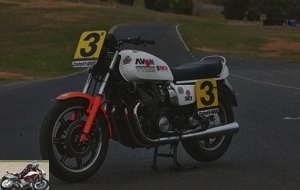 Yamaha XS1100 Team Avon review
Yamaha XS1100 Team Avon review
Discovery
Amaroo’s narrow and winding 1.94 km track is a southern hemisphere version of the Brands Hatch layout with lots of vertical drop and a majority of right turns. The event attracted no less than 20,000 spectators and a full grid of 40 motorcycles jostling each other throughout the 360 laps and more, each lap being completed in less than a minute. It was by far the largest and most prestigious motorcycle race in Australia in its 18 years of existence until 1987, with the last three races being contested at Oran Park. Then came the Australian 500 Grand Prix at Phillip Island from 1989 which in a way succeeded it.
Complete with its crucial stops for refueling and tire changes, the Six Hours were broadcast live on television in their entirety each year, until Castrol ceased to support the event in favor of Motocross and later the V8 Supercars. We are then in 1987. Its disappearance is also due to the fact that the Oran Park, longer and larger, did not offer the atmosphere of "cauldron" of Amaroo and was less spectacular to the public who, in addition , lost its attraction for series motorcycle racing in favor of the new Superbike category which was then arriving.
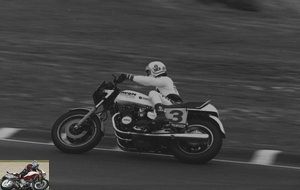 Jim Budd in the XS Avon at the Castrol 6 Hours 1978
Jim Budd in the XS Avon at the Castrol 6 Hours 1978
At their peak in the late 1970s, the Castrol Six Hours was truly the most prestigious, high-profile, best-funded and commercially important production motorcycle race on the world calendar. It was the one that mattered! As such, it enjoyed tremendous support from the motorcycle industry down to the factory level, as well as their customers in Oceania who viewed it as a full-scale test of their motorcycles and tires they they could buy. A key element of racing from its inception was that motorcycles had to be fully stock and remain similar to those found in dealerships. They were also rigorously inspected before and after the race..
Yamaha joined the party late by finally building a large displacement four-stroke model with the XS1100, launched only in 1978. Alone among the four Japanese manufacturers, the brand had so far rather focused on success in Grand Price with a two-stroke series, then adapting the benefits to its customers of all sporting levels through its TA / TD / TZ range and their RD 250/350/500 LC road versions. But with soaring demand for the new generation of four-stroke motorcycles bolstering the rise of two-wheelers around the world (in Australia, a record 80,538 motorcycles were sold in 1974 for a population of just 13.72 million. ), Yamaha could only watch Honda, Kawasaki and Suzuki, as well as Ducati and BMW fight in major endurance events like the Castrol Six Hours and enjoy the beneficial effect of "win on Sunday, sell on Monday" in concession. Yamaha could no longer wait to enter this market and the debut in 1978 of the XS1100 was the result of the brand’s work to present a model. It then proclaimed itself the fastest production motorcycle in the world, a claim reinforced by its performance in drag races, with circuit racing coming later..
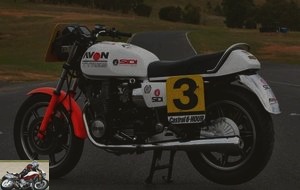 The Yamaha XS1100 Team Avon
The Yamaha XS1100 Team Avon
Confronted with the equally new GS1000 from rival Suzuki and the Kawasaki KZ900 / 1000, as well as Honda’s superb secret weapon, the six-cylinder CBX1000 launched in early 78 and presented as the fastest motorcycle, the imposing XS1100 of Yamaha (256 kg dry on the Castrol Six Hours checkweighers) used a final drive shaft using the technology acquired from BMW and thus presented itself more like a tourer than a sports car. This was especially true with the high level of torque available at mid-range of the 1,105cc air-cooled, twin overhead camshaft engine measuring 71.5 x 68.6 mm, with 90.2 Nm peaking at 6,500 rpm but also available largely over the entire rev range. Power at the rear wheel reached 95 horsepower at 8,000 rpm. But although heavier and slower than its rivals, the XS1100 established itself as a machine cut out for victory thanks to the efforts of Pitmans Motorcycles, the South Australian importer..
Evil Pitman, 67 years old and whose family business was founded in 1955, worked hand in hand with Yamaha engineers on the development of these first four-strokes:
Yamaha Japan has had a scorching time with their TX500 and TX750. And in 1976, when they introduced the three-cylinder XS750, it was to demonstrate their ability to solve the problems they had encountered so far. They really hoped that the XS750 and the bigger bikes that followed, led by the XS1100, were completely safe. So in December ’77 they sent a team consisting of a technician and three riders from Japan to spend three weeks with us while we tested the bikes in South Australia on long rides between Swan Reach, northeast of Adelaide. and Loxton then down south over the border with Victoria to Pinnaroo.
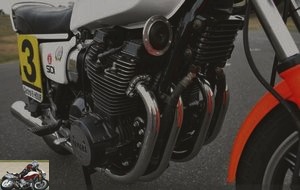 The 1.102 cc engine produced 95 hp
The 1.102 cc engine produced 95 hp
We drove 650 km every day for almost three weeks. They wanted us to go over 180 km / h constantly so they could check the durability of the engine in real use, stopping every 100 km to check the oil. They had sensors all over the bike to measure temperatures and things. It was in the middle of summer, so it was 40 ° C every day with temperatures on the road turning to 60 ° C. In this heat, the rear tires only lasted one day, before they ended up in tatters. We basically bought all of Adelaide’s 17 inch tires to keep the bike running. My cousin Dean Pitman and I got really quick on wheel changes! In addition, our rider Greg Pretty felt very comfortable at high speeds on the XS, having learned the hard way on day one that you don’t cut the throttle in the middle of the curve on a motorcycle at tree, because when you do it you lose 5 cm and you lack ground clearance! He wasn’t too hurt when he found out, so he kept riding. Afterwards he was impossible to beat when he started riding for us, also thanks to his weight of 52 kg which made it possible to compensate for the overweight of the bike. !
Pretty and the Yamaha XS1100 Pitmans instantly became the man and bike to beat in the 1978 series motorcycle racing season, winning the Adelaide Three Hours for their first time before teaming up with Mick Cole to win the Perth Four. Hours. This race allowed Cole to earn his place in the Honda CBX which arrived shortly after. Victorian Yamaha importer Milledge then clinched victory in the next race of the Sandown Three Hours in Melbourne with Bob Rosenthal driving alone from start to finish in torrential rain. On the other hand, during the Calder Two Hours, it was Cole who won on the Honda while Greg Pretty failed in fourth place in this "sprint" race. It is also the only round that will not be won by a Yamaha that year. Pretty then returned to winning the Surfers Paradise Three Hours solo before reissuing with Jeff Miller at the Castrol Six Hours. "Meet the new Boss", this is what the Yam ‘advertisements in the Australian motorcycle press used to boast about the series of victories of the Pitman XS.
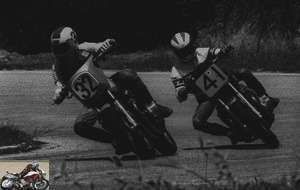 Rob Phillis on Kawasaki Z900 # 32 against Bob Rosenthal on XS1100 # 41 at Hume Weir in 1978
Rob Phillis on Kawasaki Z900 # 32 against Bob Rosenthal on XS1100 # 41 at Hume Weir in 1978
Besides the teams led by the Yamaha importer from each state (Yamaha Australia did not yet exist), the XS1100’s success in Pretty’s hands made it a machine of choice for other Six Hours competitors as it In theory, there was no special engine part as it could be the case in Superbike where only the factory teams benefited from it. For Team Avon Tires, led by importer Avon Lindsay Walker, the race was an opportunity to demonstrate the value of the new Roadrunner tire against competing products, in particular Metzeler. His team had used Kawasaki until now, with his riders Jim Budd and Roger Heyes winning the Castrol Six Hours in 1976 with a Z900. In 1978, they had so far driven Z1000 and Suzuki GS1000, without much success: the Kawasaki had too small a tank and the Suzuki had ground clearance problems. Was it worth spending on the new Yamaha ?
Lindsay walker :
With the race approaching, we debated for a while about which machine to ride and finally decided on the Yamaha. We knew it wasn’t the fastest bike in Amaroo Park, but at the same time the XS1100s had won almost every major production race in Australia so far that year. And a key point was that, despite having the larger displacement of the three motorcycles, the Yamaha was the most thrifty. And with its 20-liter tank, it could do the Six Hours with only three saves against four for the Suzuki and Honda and even five for the Kawasaki..
While the Honda had raw speed thanks to the 105 horsepower of its 1,047 cc engine allowing Graeme Crosby to clinch pole position 0.4 seconds ahead of Alan Hales’ Suzuki, questions hovered around the impact of six cylinders on tire wear. Pre-race Jim Budd made a premonitory comment: "I know there are several predictions for this year’s race, but I think it will be the year of the quick wheel change." So true !
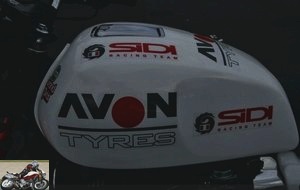 The XS had an advantage on long races by the 24 liters of its tank
The XS had an advantage on long races by the 24 liters of its tank
When the flag was waved at 10:00 am on Sunday 22 October to give the Le Mans-like start of the Castrol Six Hours, Graeme Crosby immediately took the lead of the 40 crews on his CBX. After qualifying third on the grid, Jim Budd held back a big slip at the start of the Avon XS1100 before releasing smoke throughout the first lap, which worried those following him on the track as well as in stands. Fortunately he was not given a black flag to avoid an explosion and the smoke gradually dissipated as the oil burned, the crankcase had simply been overfilled! But Budd had fallen back to ninth place when Crosby, Greg Pretty on the Yamaha Pitmans and Alan Hales on Suzuki took off. Crosby then slowed down and let Pretty take the lead, emphatically signaling his team that something was wrong with every pit pass. After just 14 laps, he brought back to the pit the Honda which was suffering from a mysterious ailment later attributed to a bad batch of fuel, leading the pre-race favorite to retire after 41 minutes of racing. By then, Hales had reclaimed the lead from Pretty, each counting a lap ahead of Budd until Hales handed over to teammate Neil CHivas. Pretty and Budd then take advantage of the larger 24-liter tank and the lower consumption of the Yamaha to stay on the track longer. The South Australian hands over to Jeff Miller who would then crash the Pitmans XS1100 40 minutes later.
Halfway through the race, Hales led the proceedings after the second pit stop and tried to regain a lap lead from the Avon Yamaha, this time with Heyes in charge, but close to having to refuel. Resilient, Heyes faced the leaders’ Suzuki for five laps until Hales fell into the Dunlop Loop, handing over the race lead to Neill and Cole in a Honda CBX. Then third, Heyes marked his pit stop and took the opportunity to make the first tire change in the race in the history of the event (banned before 1978).
Lindsay walker :
I thought this year everyone should change the tires as the higher speeds meant more tire wear on the very abrasive Amaroo asphalt. So I decided to change the tire halfway through the race, which allowed the Yamaha to start again in the race for victory since the change of a wheel is faster on a shaft drive. We practiced changing the wheel every night for a month and when we did it in the race in just barely longer than a normal refueling, it devastated the competitors..
In fact, the tire used didn’t look too worn out, but Walker rightly believed that a new rear Avon would give his riders both more performance and a psychological advantage for the second half of the race. The shutdown only lasted 74 seconds.
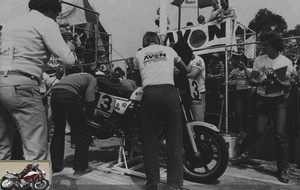 The crucial wheel change of the 1978 Castrol 6 Hours
The crucial wheel change of the 1978 Castrol 6 Hours
The new tire allowed the Yamaha to run faster than the leading Honda which in turn also had to stop to put a new Metzeler back on the instructions of the marshals to avoid safety problems. The difficult stop took 4min10 and pushed the CBX back to third place behind Warrian and Kelly’s Ducati 900SS. So Heyes crossed the finish line as the winner at 4:00 p.m. with more than one lap and a comfortable lead of almost two laps over the desmo which she had not changed her Metzeler. The 1978 victory marked the start of a long series for the XS1100 which dominated the event until the end of the event in 1987 with 5 wins in 10 participations. But it is this first success that gave the most satisfaction to the management of Yamaha..
There is another reversal in this victory since the tire change was actually the initiative of Mal and Dean Pitman! The cousins intended to perform the wheel change on their own motorcycle before Miller fell and the Pitmans Yamaha retired. They then took their equipment to the Avon box.
Evil Pitman :
We had a bit of experience changing tires after our three weeks of road testing with the Yamaha. It was nice of Lindsay asking us to do it for them !
After its race victory, Team Avon’s Yamaha XS1100 surprisingly did not end up in the factory museum in Japan, or even in the showroom of the McCullock Yamaha dealer who supplied it to Avon. Instead, the now registered motorcycle for road use was sold to Graeme Hadley who was part of the supply team during the victory at Amaroo Park. He recovered it in April 1979 and used it for his travels and trips, covering 35,000 km until 1989, when it was put in the garage after a few small accidents. Graeme died during a business trip to Japan in December 1994 and his widow Debbie sold the XS1100 to Bruce Loy, a Sydney firefighter, in 1996. Bruce cleaned up spider webs and used it in turn to his personal journeys until May 2007. At that time, it was found by Mal Pitman who wanted to get his hands on one of the Castrol Six Hours motorcycles to restore it. Bruce, who was looking for a lighter machine but still with a driveshaft, agreed to swap the XS for a newer XJ650. The two met halfway between Adelaide and Sydney to swap motorcycles. The XS1100 now had 68,856 km on the odometer and was eagerly awaiting its makeover by heading to South Australia to regain its former glory..
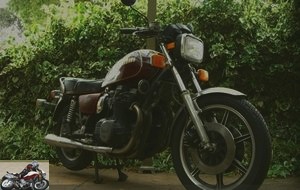 The Yamaha XS1100 when it was bought by Pitman
The Yamaha XS1100 when it was bought by Pitman
I knew this was the real bike from the engine and chassis numbers. But as soon as I took it home and started taking it apart, I found all the signs that it was a racing machine. The drain and fill plugs were drilled to pass the locking cables, as were various nuts. The footrest brackets were showing signs of wear where the plate brackets were and when I removed the taillight bracket a SIDI sponsor sticker was still underneath while the laurel wreath sticker Avon was still on the gas cap. I completely took it apart and rebuilt it from scratch. But I only wanted original parts, not aftermarket parts. So it took me seven years of work and traveling around the world to find the parts I needed, especially the exhaust system. Some engine parts were also difficult to obtain. I finally finished it in April 2014. I then drove about 600 km to break in the engine on the Adelaide Hills near my home. It worked wonderfully. So I took her to Broadford Bonanza shortly after. The event that year hosted the Castrol Six Hours Revival and Lindsay Walker was there to join this trip down memory lane..
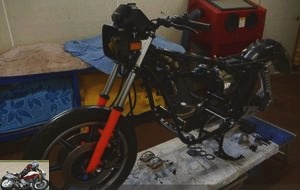 The restoration will have taken 7 years at Pitman
The restoration will have taken 7 years at Pitman
In the saddle
Since that unique appearance, the Avon Yamaha has been sold to Motorcycling Australia, the country’s national motorcycle federation, to join the many competition bikes in its collection. It is currently on display at the Bathurst Circuit Museum. Before that I was lucky that Mal Pitman offered to ride his freshly restored motorbike for sessions at the Broadford circuit..
The Broadford circuit is quite similar to that of Amaroo Park where this Yamaha rose to fame 40 years earlier. It does include a few sloping turns which are potential hazards for a shafted motorcycle like this where ground clearance is likely to be a big issue if you release the throttle too much for some reason while you are already on the road. ‘angle. I encouraged myself before getting on the soft and rather wide 810mm saddle of the Yamaha, like "make sure you have the right trajectory before taking a turn, totally brake before committing to fill. accelerate rather than brake on the angle like you might envision on a chain bike. But above all be gentle and she’ll be nice. No worries, man…
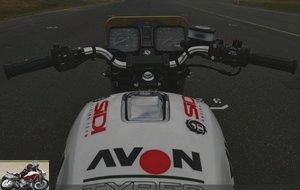 The wide handlebars help to handle this heavy machine
The wide handlebars help to handle this heavy machine
Freshly restored, the almost like new XS1100 is a nice revelation for a 40 year old motorcycle. Okay, with that open steering geometry (the Kayaba 37mm fork is open to 29.5 ° with 130mm of trail) and especially the 1.545mm long wheelbase, it’s a physical bike and you have to do significant effort to get him from one angle to the other, and even more in the downhill Esses leading behind the Broadford Paddock. We are not helped either by the 256 kg dry (278 kg with the full 24 liters). You might think it is tiring to ride, but the Yamaha doesn’t feel as heavy as the other Japanese four-cylinders of the time that I have ridden, however. Having the lower weight makes steering easier and most importantly helps handle bumps better, even with that tiny 80mm of rear wheel travel offered by stock Kayaba shocks..
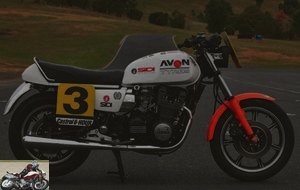 The Yamaha XS1100 is also a big rider with its 1,545 mm wheelbase
The Yamaha XS1100 is also a big rider with its 1,545 mm wheelbase
Test
In addition, the wide, fairly raised handlebars provide good leverage to maintain control and help you take the bike through the twisty track and its bends. However, the XS pulls straight ahead and remains very stable in the straight line, even when the front wheel inevitably lifts while passing the fourth. It is just as well because the rules of the Castrol Six Hours prohibited the use of a steering damper. So if your bike was rocking – and a lot of it was back then – too bad, you just had to hang on. But not with the Yamaha which remains super stable on high acceleration acceleration reinforced by the torque of 90.2 Nm available at 6,500 rpm.
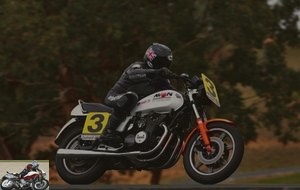 The torque is generous and reaches a maximum of 90.2 Nm at 6,500 rpm
The torque is generous and reaches a maximum of 90.2 Nm at 6,500 rpm
And that’s the key element of this bike! This hearty propulsion from the muscular engine is the exact opposite of its rival at the time, the Honda CBX 1000. Its almost square dimensions of 71.5 mm x 68.6 mm provide large and bulky cylinders, although less imposing than those of the Honda at short stroke and high revs, which translate into gear changes and a quick approach to driving that is less tiring. The XS1100 engine pulls effortlessly out of slow bends, feeling like torque comes effortlessly just by pulling the throttle open from 2,500 rpm.
It was one of the first motorcycles to adapt CV carburettors. And so, not only was there no jerk or thrill coming out of a slow curve, but the throttle response was crisp and precise – though not as aggressive as subsequent productions – but still immediate and above all controllable. The XS also featured solid-state ignition with no-load advance, an element borrowed from the automotive world that dramatically improved throttle performance with its ability to advance the ignition timing when needed. This helps the big engine deliver power smoothly no matter which RPM or gear is selected..
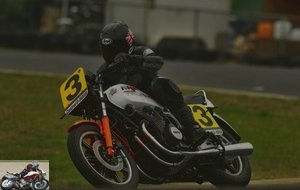 The arrival of the power is however very well dosed and dosable
The arrival of the power is however very well dosed and dosable
I enjoyed this all the more in my next session as the rear Avon Roadrunner started to skate and slide out of the right turn in second at the end of the straight. Thanks to my approved technique for approaching turns, I was ready to regain grip, taking care not to release the accelerator to stop the slide and risk losing ground clearance, but to control it with the ‘accelerator. The fact that I deliberately keep the Yamaha as straight as possible out of a corner, to use the rear Avon tread, also helped when it started to go. At the other end of that straight in the uphill turn that leads to it, the Yamaha was also starting to slide, but it was fun because everything felt very controllable thanks to the excellent carburetor and responsive but predictable throttle. , as well as tires.
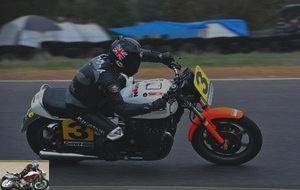 Shaft transmission requires new habits on the track
Shaft transmission requires new habits on the track
Cycle part
The only thing I didn’t really care about on the Yam was the shifting of the gearbox, which was quite hard. It is imperative to use the clutch for each upshift or downshift and especially take into account that the change is very slow. So much so that in trying to rush it, you can miss a report, as I have done twice in front of Mal Pitman. Oops !
But handling was better than I expected, especially if you keep pulling the throttle while cornering, which prevents any incipient understeer. Mal had obviously taken care to verify that the modified "Version 2" fork components supplied by Yamaha for the 1978 Six Hours were still installed, which ensured more than sufficient feedback from the Avon before and after. wasn’t dipping too much when I applied the brakes at the end of the two straights.
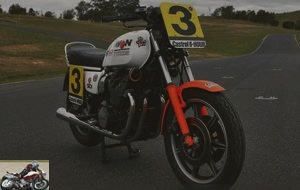 The Kayaba fork is still equipped with the elements developed by Yamaha in 1978
The Kayaba fork is still equipped with the elements developed by Yamaha in 1978
Braking
The Yamaha braked surprisingly well, although it needed firm pressure on the front lever to slow it down from 180 km / h (on the odometer, quite functional). It must be said that the front dual 298mm discs were quite large for their time. Moreover, in 1978 the Japanese had started to learn more about the materials of discs, so that their brakes were finally starting to become functional. With the final drive shaft, I was reluctant to use the engine brake too much for fear of slamming the rear end. Better to downshift in a more measured manner and get some really helpful extra help to stop the bike that way, without getting overly excited as I may have been a few times, causing the rear wheel to move around the turn. Not a good idea !
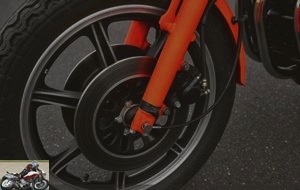 Up front, single-piston calipers brake the 298mm discs
Up front, single-piston calipers brake the 298mm discs
Watch the race in video
The start of the race
The end of the race
Conclusion
History almost repeated itself during yet another session on the bike, when I had a nice little battle with Bob Rosenthal, who had also ridden a Yamaha XS1100 at the Castrol Six Hours of 78, but who was here on Another artefact from the Motorcycle Australia collection: the Moreparts Ducati 750 SS that Mike Hailwood and Jim Scaysbrook rode in the same race and with which they had led the 750cc class until the gearbox broke. Even on such a twisty track, the Yamaha gave a good overview of its performance against the lighter and more agile Desmo, but slower, even with its slightly shorter wheelbase and this thanks to this torquey engine and maximum power. more than acceptable 95 horsepower at 8,000 rpm. At first I had started shifting at 7,500rpm or just above the maximum torque of 6,500rpm, but Pitman told me to use 1,000 revs more.
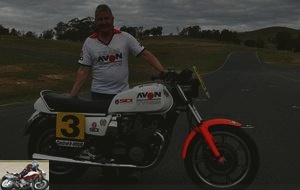 Mal Pitman and the original Yamaha XS1100 Team Avon
Mal Pitman and the original Yamaha XS1100 Team Avon
The red zone is 8,500rpm on a short circuit like this, but on the Adelaide Raceway where there’s a mile-long straight, we were always using maximum revs because we never had other box, knowing that it can reach 9000 rpm once per revolution. She always survived this !
On those fast straights Greg Pretty was reaching 235 km / h and the Yamaha was certainly faster than everyone else at this game, including the Honda CBX. She just kept on accelerating. We were lucky to have good speed even though we had a weight disadvantage, but we had an advantage on fuel and reasonable ground clearance. On the other hand, we had a disadvantage on the tires and we had to get around these points. But we were convinced that the pros would outweigh the cons, which is why we took it for the race … and won !
Strong points
- Motor
- Stability
- Maneuverability
- Braking
Weak points
- Weight
- Gearbox
The technical sheet of the Yamaha XS 1100 Team Avon Tires
Related articles
-
OJ Yamaha YZR250 OWL5 motorcycle test
The 2000 GP250 World Champion 90 ° V-twin, 249 cc, 97 hp, 268 km / h, 97 kg In 2000, Olivier Jacque dazzled Grand Prix enthusiasts riding the Yamaha of…
-
Access to the Dark Side of Japan for adults from 5199 € 42 horsepower at 10,750 rpm, 29.6 Nm of torque at 9,000 rpm, for A2 licenses At Yamaha, the MT…
-
Yamaha RZV 500R motorcycle test
GP 500 2 stroke … road ! 50 ° V4, 494 cc, 100 hp, 134 kg Sports bikers are familiar with the Yamaha RD 500 LC, inspired by Kenny Roberts’ YZR500….
-
Fashion victim ! The single-cylinder trail is out of fashion and that’s a shame. Because the Yamaha XTZ 660 Tenere remains the embodiment of the…
-
Yamaha YZF-R7 OW-02 superbike test drive
Noriyuki Haga’s motorcycle from WSBK 2000 4 cylinders in line, 749 cm3, 172 hp, 162 kg dry The four-year racing ban imposed on Andrea Iannone, now a…
-
The unfinished future The brand with three tuning forks, wishing to prove its lead in terms of technology and innovation, unveiled its 1000 GTS at the…
-
New re-evolution High-end road symbol of the manufacturer with tuning forks, the FJR 1300 descends from a long line of dynamic travelers. The first of…
-
Yamaha VMAX Cafe Racer motorcycle test
Rocket hyper modified by Roland Sands Design The Power Cruiser stripped down to lose 36 kg The Yamaha VMax is undoubtedly one of the most iconic…
-
R6, Wind and Fire With multiple sporting origins, such is the Yamaha R6, drawing its roots from different family branches of the segment. Thus, at the…
-
Test Yamaha XTZ 750 Super Tenere
Twin-cylinder in-line, 749 cm3, 70 hp, 6.8 m / kg, 195 kilos dry, from € 1,000 Produced from 1989 to 1995, this big and reliable road trail smells of…
What I find frankly unfortunate about this machine is its pachydermal weight !
With 20 kg less I would watch it.
… with the technical sheet of the M1800R (106hp), it is no longer the same bike 🙂
With a monthly minimum wage of 500 francs, there is a calasse in the simulator…
 .
.
24,000 francs, that’s never more than 50 months of minimum wage
I am of the same opinion as the previous comment. Rare are the tests of this machine which transcribe reality. Creator of the Forum http://www.suzuki-M1800r.com, I can tell you that this article delighted many members, well done.
Thank you both, it’s nice.
Other tests? yes, there are quite a few. I hope they will have the same success with you.
gross decofrage and a real pleasure for two however motorcycle reserved for initiates and young biker to watch from afar as pleasure
My first bike, a Gladius 4 years ago, already had Qualifer 1s: long to heat up, the front tended to engage on the angle, and especially very average in the rain … I think there is Had a way to switch to newer tires of better overall quality … otherwise the price will be decisive, and if it does not sell like the Gladius, therefore wait for the manufacturer’s promotions which will not be long, Suzuki is accustomed to the fact … .result I sold my Gladius bought new two years later to be able to sell it…..
Otherwise I loved its torquey and angry v twin, the physique is debatable, to see in real life … you will have to change the Qualifer tires if you want a homogeneous motorcycle …